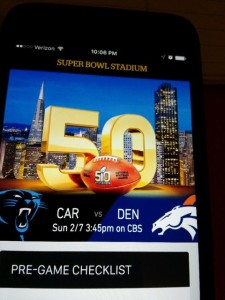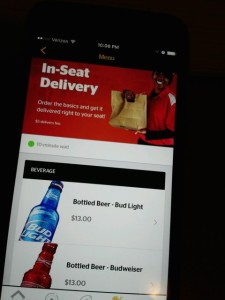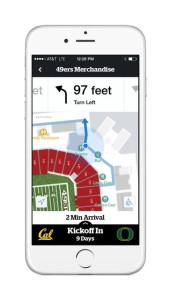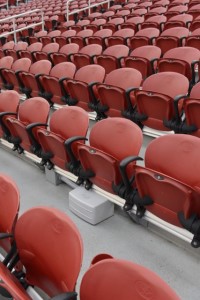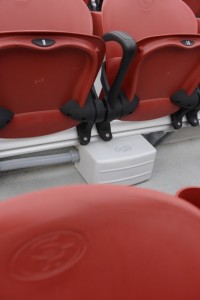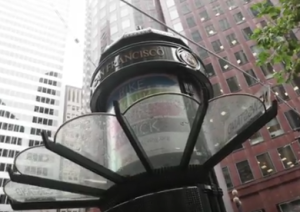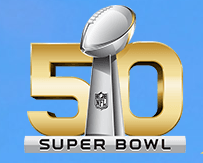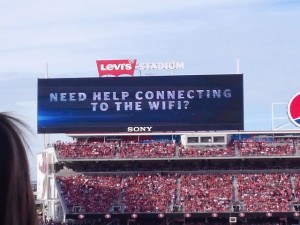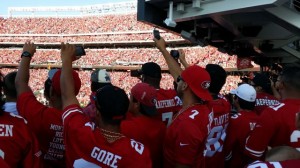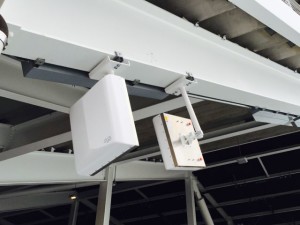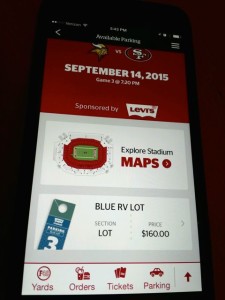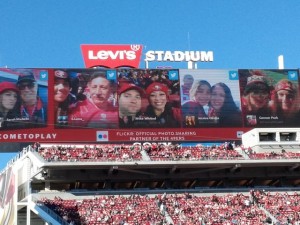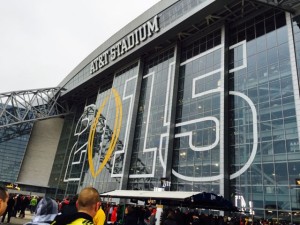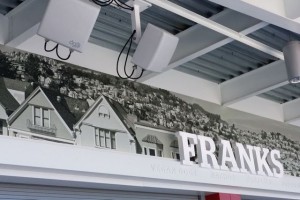While the app originally showed food items available for delivery service when it went live Wednesday night, by Thursday morning only beverages were showing up in the In-Seat Delivery menu. Food items and merchandise, however, can be ordered in advance and picked up at express windows throughout the stadium.
Developed for the NFL by VenueNext, the developer behind the regular Levi’s Stadium app, the Super Bowl 50 stadium app otherwise has most of the regular bells and whistles enjoyed by San Francisco 49ers fans the last two seasons, including the live wayfinding maps feature.
In a quick run-through of the app the other new feature we didn’t see was the ability to send food and beverages to a friend in the stadium, which makes sense to leave out since a Super Bowl crowd probably doesn’t have as many friends at the venue as a regular Niners crowd would. The Super Bowl 50 stadium app also has some NFL-specific add-ons, including a Super Bowl Fan Guide (what to bring, what not to bring) and a link to the NFL Experience promotional site, as well as a direct link to download the NFL Mobile App. Features not visible yet on the app that will be there for game day include game-action instant replays, as well as a “Celebrity cam” and a way to see Super Bowl commercials from the game broadcast via the app after they air on TV.
Niners, NFL agreed on keeping food delivery sidelined
If there was a component that would really make this Super Bowl different from past Super Bowls it would have been regular Levi’s Stadium food-ordering and delivery options, which are unmatched in any other large stadium we are aware of. From our personal experience the food ordering and delivery system worked well at a past Niners regular-season game, and enabled us to watch a full Niners touchdown drive instead of having to stand in a line to purchase a beer and a pretzel.
In its first year the in-seat delivery service was only used a couple thousand times a game at most during Niners regular season home games, which apparently didn’t stress the system. But at the first real “big event” at Levi’s Stadium — the Coors Light Stadium Series outdoor hockey game between the San Jose Sharks and the Los Angeles Kings on Feb. 21, 2015 — a massive amount of food orders by hockey fans overwhelmed the delivery system, leading to long wait times and many canceled orders, and lots of frustrated fans.It didn’t help that the stadium that night also suffered from some Wi-Fi outages and some disconnect on the Verizon cellular network, but the failure of the app and the delivery system (which included not having enough human runners on hand to fulfill all the orders) introduced doubt as to whether Levi’s Stadium could deliver on its delivery promise for a big-game crowd.
According to San Francisco 49ers chief operating officer Al Guido, the decision to only have beverage deliveries at Super Bowl 50 was one reached jointly by the NFL, the Niners and VenueNext, and the catering company for the stadium, Centerplate. In a phone interview Friday Guido said that the potential “amount of education” for all the fans new to the stadium and new to the app led the league, the Niners and the caterers toward a path of greater simplicity, namely just having beverages available for in-seat delivery.
“It was a risk-reward decision about the amount of fan education needed,” Guido said. “There’s so much going on at a Super Bowl and so many people new to the stadium that it didn’t seem worth it to us to risk someone not getting an order delivered because of their error, or our error.” Guido added that with all the extra breaks in action for a Super Bowl, and additional concessions stands, “there’s enough time to get around” to get food.
At the very least, Super Bowl 50 fans won’t need to leave their seats to order beer, wine, sodas, Gatorade and water, the only items currently on the delivery list. What shouldn’t be a big concern to the high-rolling Super Bowl attendees is the $5 service charge for delivery and the high concession prices, including the $13 bottle of Bud Light. For the record, Guido said the delivery system performed at similar levels this regular season compared to last, with about 2,000 to 2,500 delivery orders per game.
The app can also determine which windows are closest or have the shortest lines, to help fans satisfy their hunger or thirst needs as efficiently as possible. Using the express pickup option, fans can choose items and pay for them and have them ready for quick pickup at the closest or least-trafficked nearby stand, also cutting the time needed to get fed.Directions, maps helpful too
What also might be extremely helpful to many of the first-time Levi’s Stadium visitors are the app’s ability to get fans to Levi’s Stadium, and then help them find their way around once they get there. The former feature is one we’ve been having fun with since it links to Google Maps and gives fans options for public transit, walking and bicycling to the stadium — according to the app it will only take us 16 days to walk to Levi’s Stadium from our home here in Boulder, Colo., or five days by bike. Apparently the app isn’t familiar with winter or mountains, but that shouldn’t affect those who use it while in the San Francisco Bay area.
Inside the stadium, the 2,000+ Bluetooth beacons allow the app to offer interactive wayfinding, via maps that show users as a familiar blue dot walking around the stadium. Fans will need to turn on location services and Bluetooth for the mapping features to work.
